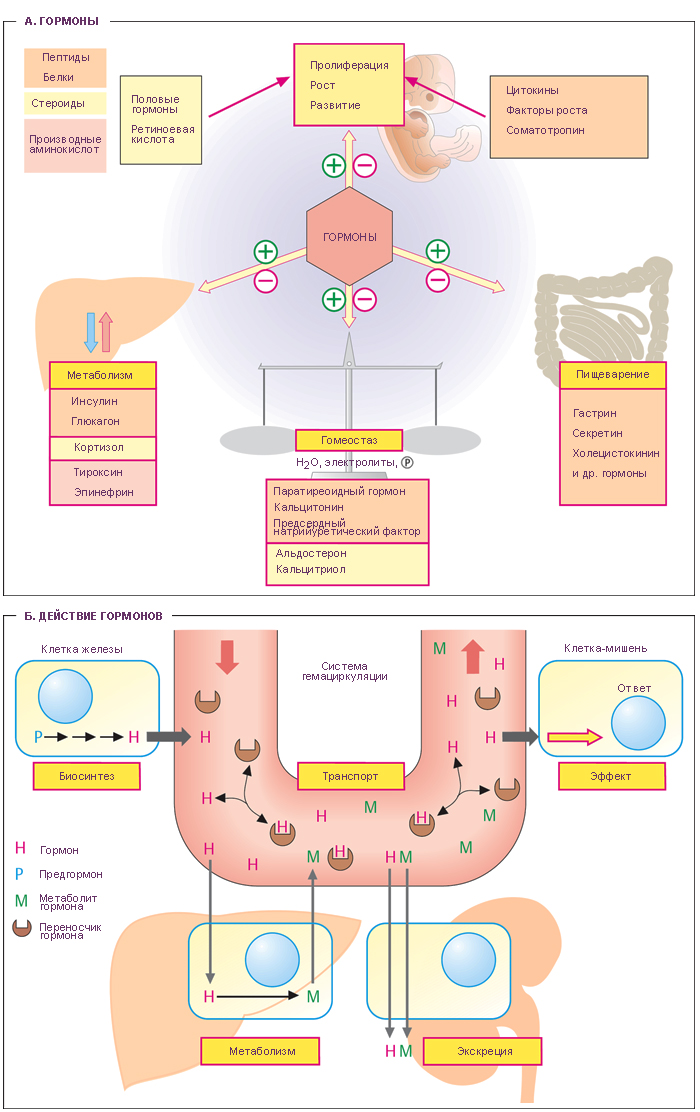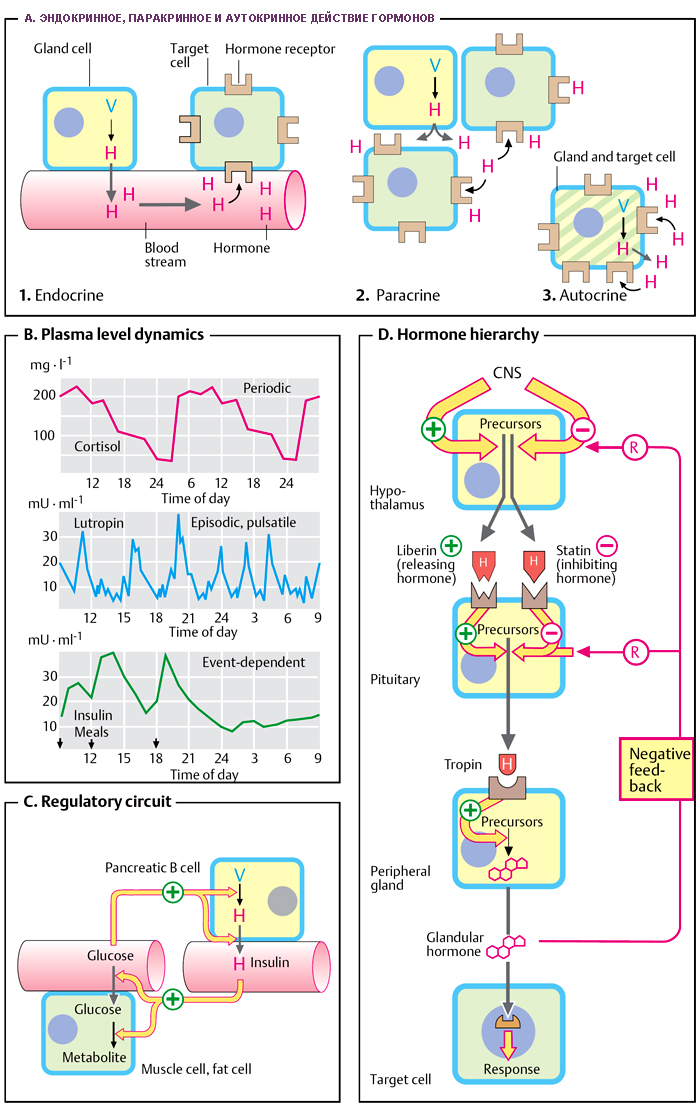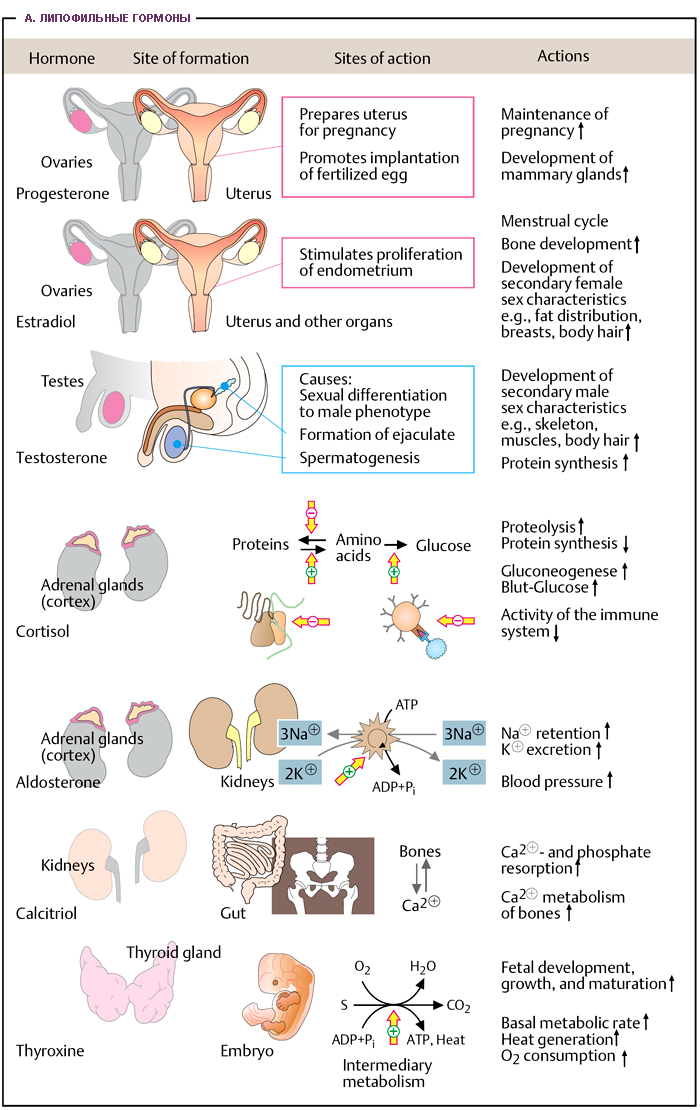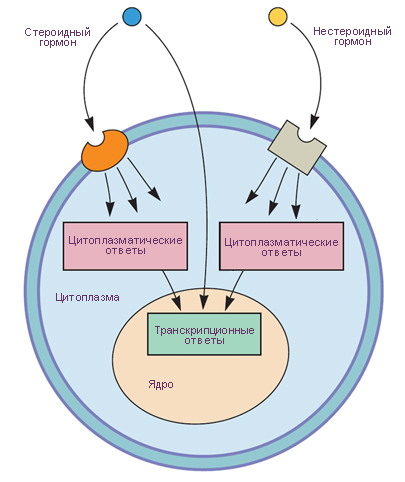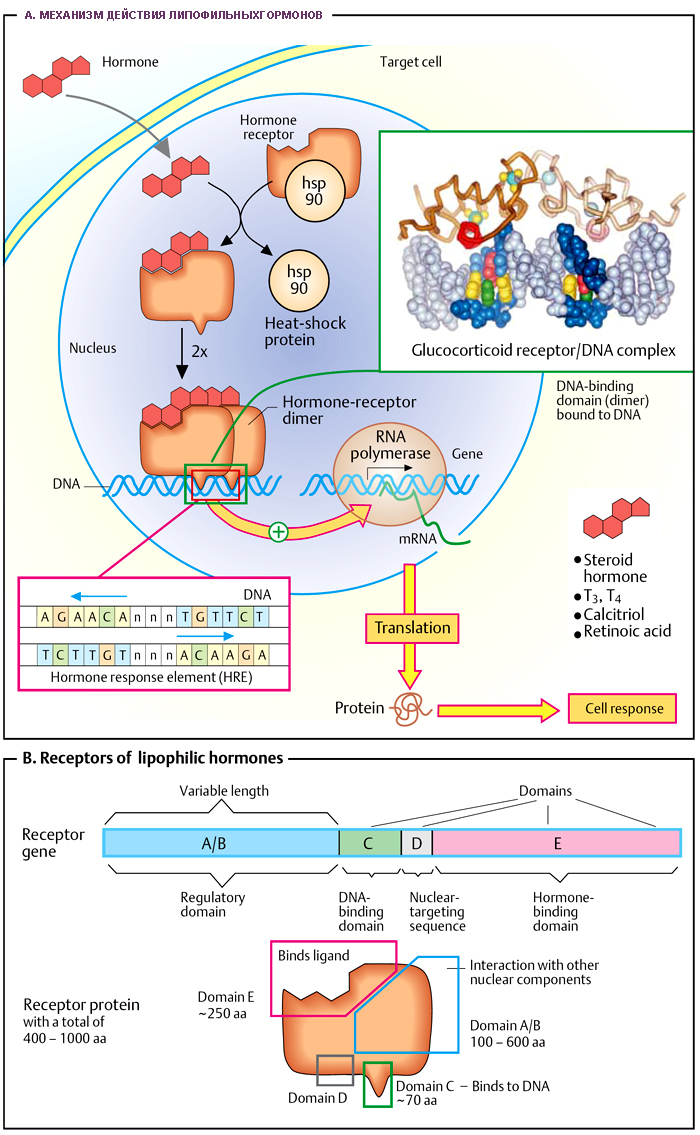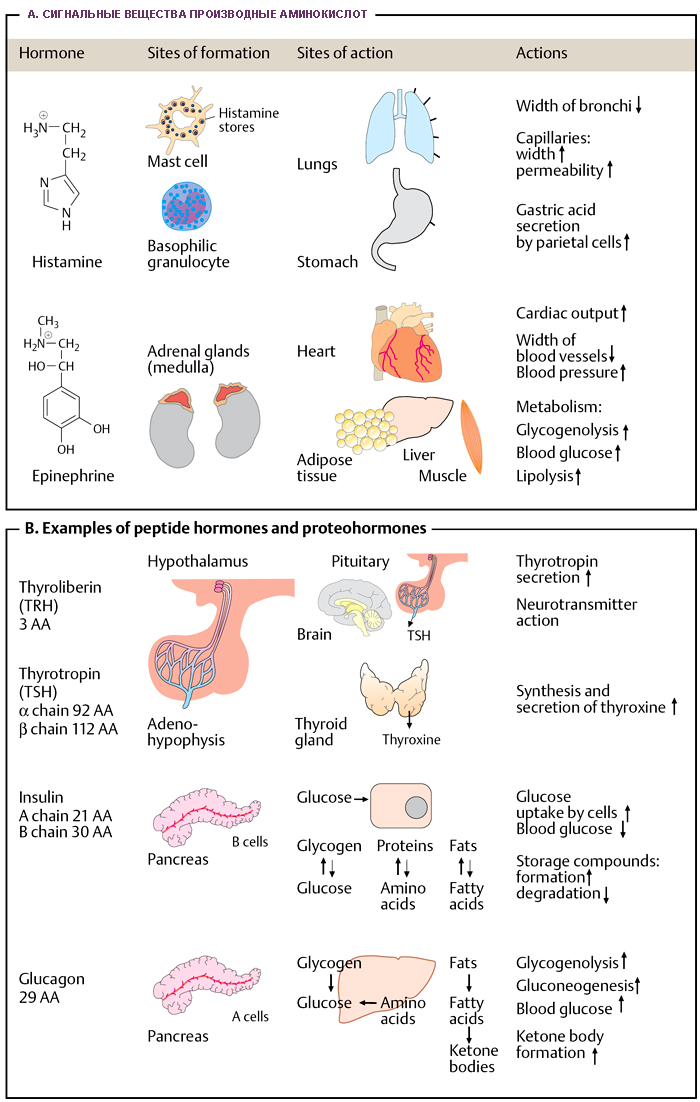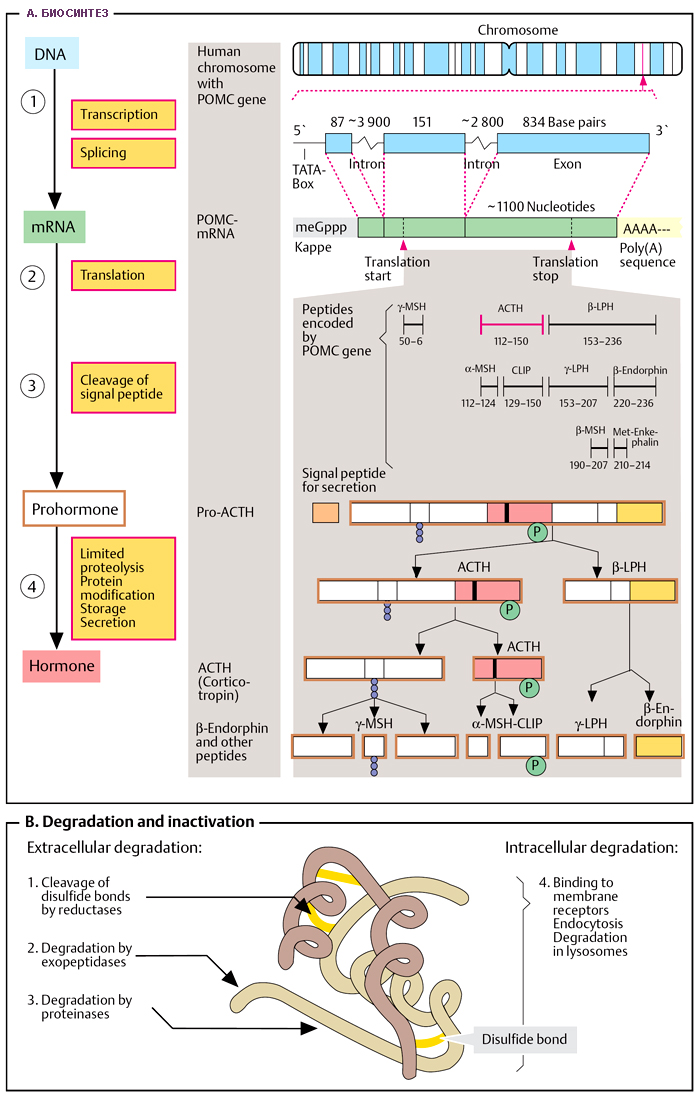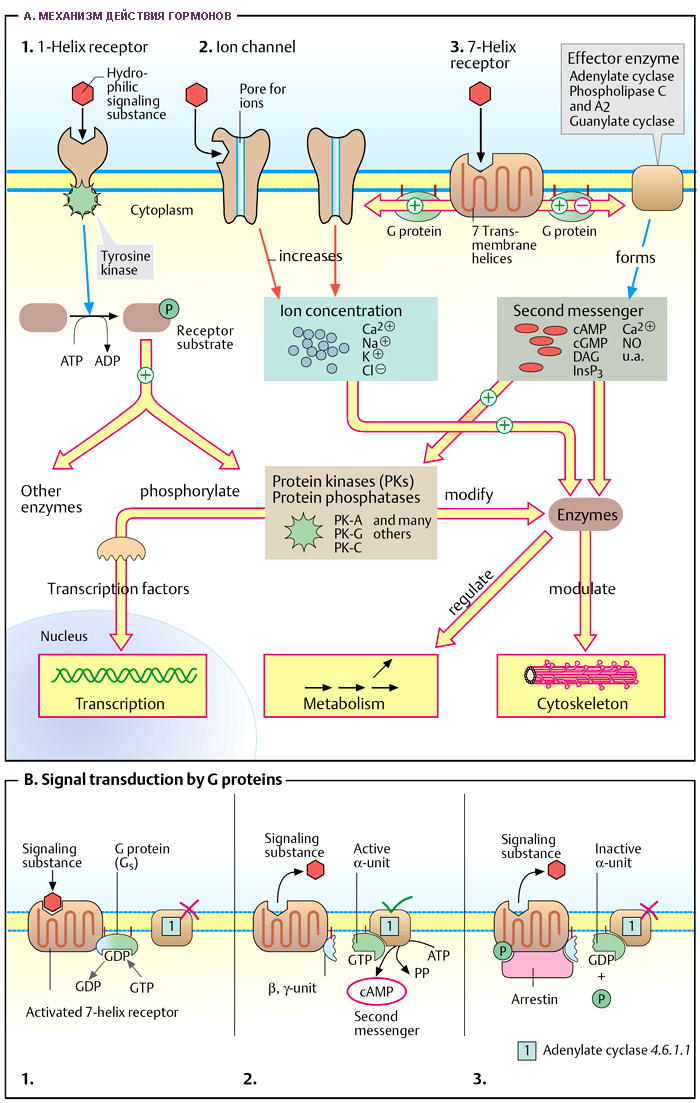| Психология | Соматология | Математика | Физика | Химия | Наука Общая лексика |
| А | Б | В | Г | Д | Е | Ж | З | И | К | Л | М | Н | О | П | Р | С | Т | У | Ф | Х | Ц | Ч | Ш | Щ | Э | Ю | Я |
| A | B | C | D | E | F | G | H | I | J | K | L | M | N | O | P | Q | R | S | T | U | V | W | X | Y | Z |
|
(Лат.: classis - разряд, класс, группа, смена; facio - делать, производить, совершать, изготовлять; 1790).
(1905, Греч.: όρμάω - двигать, побуждать, возбуждать).
Классификация гормонов - это распределение (процесс и/или его результат) множества гормонов на подмножества, классы, по определенным признакам их различия или сходства. Структурная классификация основана на раскрытии сущности классифицируемых объектов.
Гормон - это биоактивное вещество, вырабатываемое эндокриноцитами - клетками эндокринной системы. Гормоны являются средством управления, носителями управляющей информации для объектов управления: клеток-мишеней, органов-мишеней и систем организма. Исследование гормонов является одной из целей, предметом интересов эндокринологии.
Главными признаками вероятностного различия или сходства, являющимися ос новой для распределения гормонов на классы являются: (а) наиболее вероятная химическая структура гормонов и (б) наиболее вероятные место естественного синтеза гормонов и механизм их действия. В соответствии с этими признаками созданы: химическая классификация гормонов, основанная на их химической номенклатуре и тривиальная классификация гормонов, основанная на их тривиальной номенклатуре. Примеры химических названий: 1) пептидные и белковые гормоны, 2) гормоны - производные аминокислот, 3) гормоны-стероиды, 4) эйкозаноиды. Примеры тривиальных названий: гормоны гипоталамуса, гормоны гипофиза, гормоны щитовидной железы, гормоны надпочечников, гормоны поджелудочной железы, гормоны половых желёз и др. Полного согласия специалистов по вопросам номенклатуры и классификации гормонов не существует. Современные рекомендации по номинации гормонов излагаются в международных публикациях (см. в отдельном окне Литература, иллюстрации).
Таблица. Химическая классификация основных гормонов = Chemical Classification оf Selected Hormones. Hormone A. Peptide Hormones
Adrenocorticotropin (ACTH)
Atrial natriuretic peptide (ANP)
Arginine vasopressin (AVP) (also known as antidiuretic hormone [ADH])
Calcitonin
Cholecystokinin (CCK)
Corticotropin-releasing hormone (CRH)
Follicle-stimulating hormone (FSH)
Glucagon
Gonadotropin-releasing hormone (GnRH)
Growth hormone (GH)
Growth hormone-releasing hormone (GHRH)
Inhibin
Insulin
Insulin-like growth factors I and II (IGFs)
Luteinizing hormone (LH)
Oxytocin (OT)
Parathyroid hormone (PTH)
Prolactin (PRL)
Secretin
Somatostatin
Thyrotropin (TSH)
Thyrotropin-releasing hormone (TRH)
Vasoactive intestinal peptide (VIP)
B. Amino Acid Hormones
Dopamine (DA)
Epinephrine (Epi), aka adrenaline
Norepinephrine (NE), aka noradrenaline
Serotonin, aka 5-hydroxytryptamine (5-HT)
C. Steroid Hormones
Aldosterone
Cortisol
Estradiol (E2)
Progesterone
Testosterone
Примечание:
Таблица. Основные гормоны позвоночных = Common Vertebrate Hormones. Hormone Structure Functions Skeletal Muscle Hormones Irisin 22kDa proteolytic fragment of the transmembrane protein FNDC5 (fibronectin type III domain-containing protein 5) Expression induced, in skeletal muscle, by PGC1-? in response to exercise, induces a conversion of white adipose tissue (WAT) into a more brown fat (BAT) type, generally referred to as beige or brite fat cells Pituitary Hormones Oxytocin Posterior pituitary peptide; polypeptide of 9 amino acids CYIQNCPLG (C's are disulfide bonded) Uterine contraction, causes milk ejection in lactating females (the "let-down" response), responds to suckling reflex and estradiol, lowers steroid synthesis in testes
+--- Vasopressin
(antidiuretic hormone, ADH) Posterior pituitary peptide; polypeptide of 9 amino acids CYFQNCPRG (C's are disulfide bonded) Responds to osmoreceptor which senses extracellular [Na+], blood pressure regulation, increases H2O readsorption from distal tubules in kidney, loss results in dilute urine and polydipsia (constant thirst) condition termed diabetes insipidus Melanocyte-stimulating hormones (MSH) Anterior pituitary peptides derived from POMC:
α-MSH most significant, involved in control of appetite and feeding behaviors via melanocortin receptor (MC4R)-expressing neurons in hypothalamus, immunomodulation via MC1R-expressing monocytes, macrophages, and dendritic cells (DCs), down-regulates the production of proinflammatory and immunomodulating cytokines (IL-1, IL-6, TNF-?, IL-2, IFN-?, IL-4, IL-13) as well as the expression of costimulatory molecules (CD86, CD40, ICAM-1) on antigen-presenting DCs Adrenocorticotropic hormone (ACTH) also called corticotropin Anterior pituitary peptide derived from POMC; polypeptide = 39 amino acidsStimulates cells of adrenal gland to increase steroid synthesis and secretion Stimulates cells of adrenal gland to increase steroid synthesis and secretion Lipotropin (LPH) Anterior pituitary peptides derived from POMC:
Increases fatty acid release from adipocytes Thyrotropin (thyroid-stimulating hormone, TSH) Anterior pituitary peptides; 2 proteins: α is 96 amino acids; β is 112 Acts on thyroid follicle cells to stimulate throid hormone synthesis Growth hormone (GH, or somatotropin) Anterior pituitary peptide; protein of 191 amino acids General anabolic stimulant, increases release of insulin-like growth factor-I (IGF-I), cell growth and bone sulfation Prolactin (PRL) Anterior pituitary peptide; protein of 197 amino acids Stimulates differentiation of secretory cells of mammary gland and stimulates milk synthesis Luteinizing hormone (LH); human chorionic gonadotropin (hCG) is similar and produced in placenta Anterior pituitary peptides; 2 proteins: α is 96 amino acids; β is 121 Increases ovarian progesterone synthesis, luteinization; acts on Leydig cells of testes to increase testosterone synthesis and release and increases interstitial cell development Follicle-stimulating hormone (FSH) Anterior pituitary peptides; 2 proteins: α is 96 amino acids; β is 120 Ovarian follicle development and ovulation, increases estrogen production; acts on Sertoli cells of semiferous tubule to increase spermatogenesis Hypothalamic Hormones & Peptides Orexins 2 peptides from single preproprotein; orexin A is 33 amino acids, orexin B is 28 amino acids Important roles in the emotional and motivational aspects of feeding behavior, increases food consumption (orexigenic) hence derivation of peptide name; increases wakefulness and suppresses REM sleep Melanin-concentrating hormone, MCH 19 amino acid cyclic peptide Important orexigenic (appetite stimulating) hormone Neuropeptide Y, NPY 36 amino acids, 5 receptors termed Y receptors Effects on hypothalamic function in appetite, controls feeding behavior and energy homeostasis, levels increase during starvation to induce food intake Corticotropin-releasing factor (CRF or CRH) Protein of 41 amino acids Acts on corticotrope to release ACTH and β-endorphin (lipotropin) Gonadotropin-releasing factor (GnRF or GnRH) Polypeptide of 10 amino acids Acts on gonadotrope to release LH and FSH Prolactin-releasing factor (PRF) This may be TRH Acts on lactotrope to release prolactin Prolactin-release inhibiting factor (PIF or PIH) Is the neurotransmitter dopamine Acts on lactotrope to inhibit prolactin release Growth hormone-releasing factor (GRF or GRH) Protein of 40 and 44 amino acids Stimulates GH secretion Somatostatin (SIF, also called growth hormone-release inhibiting factor, GIF) Polypeptide of 14 and 28 amino acids Inhibits GH and TSH secretion Thyrotropin-releasing factor (TRH or TRF) Peptide of 3 amino acids: EHP Stimulates TSH and prolactin secretion Thyroid Hormones Thyroxine and triiodothyronine Iodinated dityrosine derivatives Responds to TSH and stimulates oxidations in many cells Calcitonin Protein of 32 amino acids Produced in parafollicular C cells of the thyroid, regulation of Ca2+ and Pi metabolism Calcitonin gene-related peptide (CGRP) Protein of 37 amino acids, product of the calcitonin gene derived by alternative splicing of the precursor mRNA in the brain Acts as a vasodilator Parathyroid Hormones Parathyroid hormone (PTH) Protein of 84 amino acids Regulation of Ca2+ and Pi metabolism, stimulates bone resorption thus increasing serum [Ca2+], stimulates Pi secretion by kidneys Adipose Tissue Hormones Leptin 167 amino acid precursor processed to 146 amino acids Regulation of overall body weight by limiting food intake and increasing energy expenditure, regulation of the neuroendocrine axis, inflammatory responses, blood pressure, and bone mass Adiponectin 244 amino acid protein with 4 distinct functional domains Major biological actions are increases in insulin sensitivity and fatty acid oxidation Resistin 108 amino acid pre-protein in humans Induces insulin resistance Hormones and Peptides of the Gut Cholecystokinin, CCK Predominant form is 33 amino acids Stimulates gallbladder contraction and bile flow, increases secretion of digestive enzymes from pancreas Enterostatin Derived from N-terminal end of pancreatic colipase; pentapeptide sequence of human enterostatin is APGPR Regulates fat intake, peripheral or central administration inhibits consumption of a high-fat diet but not a low-fat diet Gastrin 17 amino acids (little gastrin) and 34 amino acids (big gastrin) Produced by stomach antrum, stimulates acid and pepsin secretion, also stimulates pancreatic secretions Gastrin-releasing peptide (GRP); a bombesin-like peptide family member 27 amino acids Stimulates release of gastrin from G cells of the stomach and CCK from small intestinal enteroendocrine I cells Ghrelin 28 amino acids derived from preproghrelin protein; acylated on Ser3 with n-octanoic acid, non-acylated forms found in circulation also but not bioactive Appetite stimulation, stimulates NPY release, regulation of energy homeostasis, glucose metabolism, gastric secretion and emptying, insulin secretion Glucagon-like peptide 1 (GLP-1) formerly called enteroglucagon Two forms: 31 amino acids, GLP-1(7-37) and 30 amino acids, GLP-1(7-36)amide Potentiates glucose-dependent insulin secretion, inhibits glucagon secretion, inhibits gastric emptying Glucose-dependent insulinotropic polypeptide (GIP) originally called gastric inhibitory polypeptide 42 amino acids Inhibits secretion of gastric acid, enhances insulin secretion Motilin 22 amino acids Controls gastrointestinal muscles, stimulates release of PP, stimulates gallbladder contractions Neuromedin B; a bombesin-like peptide family member 10 amino acids (amidated) Secretion of gastrin, CCK, GIP, insulin; smooth muscle contraction; enhances food intake Obestatin 23 amino acids derived from preproghrelin protein Acts in opposition to ghrelin action on appetite Oxyntomodulin 37 amino acids, the first 29 are identical to glucagon Contains all of the amino acids of glucagon (see Figure below); inhibits meal-stimulated gastric acid secretion similar to GLP-1 and GLP-2 action; induces satiety, decreases weight gain, and increases energy consumption; has weak affinity for GLP-1 receptor as well as glucagon receptor, may mimic glucagon actions in liver and pancreas Secretin 27 amino acids Secreted from duodenum at pH values below 4.5, stimulates pancreatic acinar cells to release bicarbonate and H2O Somatostatin 14 amino acid version Inhibits release and action of numerous gut peptides, e.g. CKK, OXM, PP, gastrin, secretin, motilin, GIP; also inhibits insulin and glucagon secretion from pancreas Substance P, a member of the tachykinin family that includes neurokinin A (NKA) and neurokinin B (NKB) 11 amino acids CNS function in pain (nociception), involved in vomit reflex, stimulates salivary secretions, induces vasodilation;
antagonists have anti-depressant properties Vasoactive intestinal peptide (VIP) 28 amino acids Produced by hypothalamus and GI tract, relaxes the GI, inhibits acid and pepsin secretion, acts as a neurotransmitter in peripheral autonomic nervous system, increases secretion of H2O and electrolytes from pancreas and gut Pancreatic Polypeptide (polypeptide fold) Family Pancreatic Polypeptide, PP 36 amino acids Suppresses glucose-induced insulin secretion, inhibits bicarbonate and protein secretion from pancreas Peptide Tyrosine Tyrosine, PYY 36 amino acids Inhibits gastric motility by inhibiting cholinergic neurotransmission, inhibits gastric acid secretion, induces sensations of satiety Neuropeptide Y, NPY 36 amino acids, 5 receptors termed Y receptors Effects on hypothalamic function in appetite, controls feeding behavior and energy homeostasis, levels increase during starvation to induce food intake Amphiregulin 2 peptides: 78 amino acid truncated form and 84 amino acid form with 6 additional N-terminal amino acids Homology to EGF and binds to the EGF receptor (EGFR) Pancreatic Hormones Amylin 37 amino acids, intrachain disulfide bonded Also called islet amyloid polypeptide (IAPP), produced by β-cells of the pancreas, co-secreted with insulin; reductes the rate of gastric emptying, suppresses of food intake, and suppresses post-meal glucagon secretion Insulin Disulfide bonded dipeptide of 21 and 30 amino acids Produced by β-cells of the pancreas, increases glucose uptake and utilization, increases lipogenesis, general anabolic effects Glucagon Polypeptide of 29 amino acids Produced by β-cells of the pancreas, increases lipid mobilization and glycogenolysis in order to increase blood glucose levels Pancreatic polypeptide, PP Polypeptide of 36 amino acids Increases glycogenolysis, regulation of gastrointestinal activity Somatostatin 14 amino acid version Inhibition of glucagon and somatotropin release Placental Hormones Estrogens Steroids Maintenance of pregnancy Progestins Steroids Mimic action of progesterone Chorionic gonadotropin 2 proteins: α is 96 amino acids; α is 147 Activity similar to LH Chorionic somatomammotropin
also called placental lactogen Protein of 191 amino acids Acts like prolactin and GH Relaxin 2 proteins of 22 and 32 amino acids Produced in ovarian corpus luteum, inhibits myometrial contractions, secretion increases durin gestation Gonadal Hormones Estrogens (ovarian) Steroids: estradiol and estrone Maturation and function of female secondary sex organs Progestins (ovarian) Steroid: progesterone Implantation of ovum and maintenance of pregnancy Androgens (testicular) Steroid: testosterone Maturation and function of male secondary sex organs Inhibins A and B 1 protein (α is 134 amino acids; β is 115 and 116 amino acids) Inhibition of FSH secretion Adrenal Cortical Hormones Glucocorticoids Steroids: cortisol and corticosterone Diverse effects on inflammation and protein synthesis Mineralocorticoids Steroids: aldosterone Maintenance of salt balance Adrenal Medullary Hormones Epinephrine (adrenalin) Derived from tyrosine Classic "fight-or-flight" response, increases glycogenolysis, lipid mobilization, smooth muscle contraction, cardiac function, binds to all classes of catecholamine receptors (α- and β-adrenergic) Norepinephrine (noradrenalin) Derived from tyrosine Classic "fight-or-flight" response, lipid mobilization, arteriole contraction, also acts as neurotransmitter in the CNS, released from noradrenergic neurons, binds all catecholamine receptors except α2-adrenergic Liver Hormones Angiotensin II Polypeptide of 8 amino acids derived from angiotensinogen (present in the α2-globulin fraction of plasma) which is cleaved by the kidney enzyme renin to give the decapeptide, angiotensin I, the C-terminal 2 amino acids are then released (by action of angiotensin-converting enzyme, ACE) to yield angiotensin II Responsible for essential hypertension through stimulated synthesis and release of aldosterone from adrenal cells Kidney Hormones Calcitriol [1,25-(OH)2-vitamin D3] Derived from 7-dehydrocholesterol Responsible for maintenance of calcium and phosphorous homeostasis, increases intestinal Ca2+ uptake, regulates bone mineralization Cardiac Hormones Atrial natriuretic peptide (ANP) Several active peptides cleaved from a 126 amino acid precursor Released from heart atria in response to hypovolemia, acts on outer adrenal cells to decrease aldosterone production; smooth muscle relaxation Pineal Hormones Melatonin N-acetyl-5-methoxytryptamine Regulation of circadian rhythms
Примечание:
Схема. Гормоны и их действие.
Схема. Иерархия гормонов и их действие.
Схема. Липофильные гормоны.
Схема. Действие гормонов.
Примечание: Нестероидные гормоны связываются исключительно с биохимическими рецепторами плазмалеммы. Эти рецепторы являются посредниками в ответе клетки на действие гормона.
Схема. Механизм действия липофильных гормонов.
Схема. Гидрофильные гормоны.
Схема. Метаболизм пептидных гормонов.
Схема. Механизм действия гидрофильных биоактивных веществ.
!!!!!!!!!!!!!!!!!!!!!!!http://biokhimija.ru/lekcii-po-biohimii/25-gormony/164-mehanizm-dejstvija.html
|
|||||||||||||||||||||||||||||||||||||||||||||||||||||||||||||||||||||||||||||||||||||||||||||||||||||||||||||||||||||||||||||||||||||||||||||||||||||||||||||||||||||||||||||||||||||||||||||||||||||||||||||||||||||||||||||||||||||||||||||||||||||||||||||||||||||||||||||||||||||||||||||||||||||||||||||||||||||||||||||||||||||||||||||||||||||||||||||||||||||||||||||||||||||||||||||||||||||||||||||||||||||||||||||||
Санкт-Петербург, Россия, 1996-2015
Разрешается некоммерческое цитирование материалов данной энциклопедии при условии
полного указания источника заимствования: имени автора, названия и WEB-адреcа данной энциклопедии
| Автор | Новые идеи | Индекс | Библиотека | Поиск | Отзывы | Ссылка | Пожертвования | Параллельный сайт |
Всего посетителей = Altogether Visitors :
Посетителей раздела «Соматология» = Visitors of section «Somatlogy» : |
